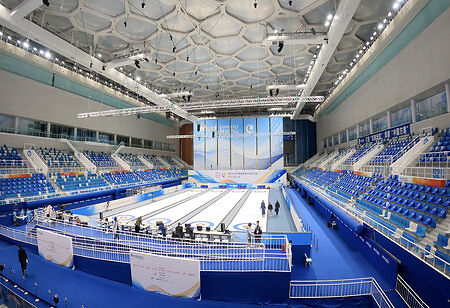
China's Carbon-Neutral Winter Olympics


China has the second-largest economy and is a major carbon emitter. But the Winter Olympics Games in China is setting a new benchmark as the first carbon-neutral winter Olympics. In a way, the games show that the country is serious about achieving its ambitious climate goals in alignment with its aim to be carbon neutral by 2060. It is making significant progress, and while not yet perfect, the clean energy preparations made for the games have accelerated China’s progress in some areas since the infrastructure and technology will remain long after the athletes leave.
Last year the country increased the capacity of renewable energy sources by about one billion kilowatts, that is, double the energy used since 2015. In the transportation sector, battery-electric, plug-in hybrid, and fuel cell vehicles reached 7.84 million, making it the biggest clean car market globally.
As China is concerned about global warming, it is working towards achieving carbon neutrality through the Olympics in tandem with other concerns such as water usage in snow-making and tree-felling for building the parts of the Olympic village have raised environmental concerns. The renewable energy constructions made in the three Olympic sites such as Beijing, Yanqing, and Zhangjiakou could effectively reshape the local energy mix after the games, laying a solid foundation for the low-carbon transition of the three. The low-carbon venues and transportation could also drive low-carbon sports tourism in the Zhangjiakou area.
The concept of the green Olympics is not new. In fact, in 2012, the London 2012 summer Olympics designed the first certifiable international Sustainability Management System standard. The Tokyo 2020 summer Olympics also managed to leverage innovative technologies to reduce the carbon emissions of the event. However, the ice and snow sports of the winter Olympics are a completely different challenge since ice and snow sports have a higher energy demand. Likewise, the Beijing 2022 Olympics is adopting a series of dynamic measures with innovative technologies in electricity, buildings, transportation, and more to eliminate the games’ carbon footprint.
Most of that reduction comes from the absence of overseas spectators at the Beijing Games due to China's zero-COVID protocols. The committee said that the lower number of international flights is said to mean 512,000 tons of CO2 emissions less than earlier projections. Total greenhouses gases emissions could reach 1.028 million tons of carbon dioxide equivalent throughout the preparation and post-Beijing Games in 2016-2022, compared to about a third less than the 1.6 million tons emitted for South Korea's Pyeongchang Games in 2018.
Yuri Ushakov, Putin's foreign affairs adviser, says that “Moscow and Beijing plan to issue a joint statement that will reflect their shared views on global security, as officials from the two countries are set to sign more than a dozen agreements on trade, energy and other issues.”
“(The Chinese) want sustainability to be the heart of how they prepare and host the Games,” says Marie Sallois, Director of Corporate and Sustainable Development, The International Olympics Committee.
Below are four methods that are greening China’s Olympic Games:
Green Electricity Supply
The intention is to organize Olympic Games with renewable energy. Zhangjiakou is a national-level demonstration zone for renewable energy. Currently, it produces 2,000 MW of renewable generation. An advanced flexible direct current (VSC HVDC) transmission line connecting Zhangjiakou and Beijing is now in operation, allowing Zhangjiakou's wind and solar power to be delivered to all venues across three competition zones. The new transmission line has the highest voltage level and the largest transmission capacity among all VSC HVDC projects worldwide and adopts several of the world’s leading technologies.
The green power market, launched in September 2021 nationwide, guarantees that renewables through green power transactions fulfill all Olympic venues’ energy demands. The measures adopted enable these Olympics to be the first in history to achieve 100 percent of its Games-time electricity demand with renewable energy.
Energy Efficient Venues
By leveraging the latest renovation technologies, China maximizes the use of existing venues. The 2008 Olympic venues used for daily sports and concerts will now be used again for the winter Olympics, with many promising green retrofits. All of the newly built venues have been certified as three-star green buildings. China also developed a new Evaluation Standard for Green Snow Sports Venues, filling the gap of relevant standards domestically and internationally.
Clean Cooling Technology
Producing ice for the games consumes a lot of energy. But for the first time in the history of the winter Olympics, a carbon dioxide trans-critical direct refrigeration technology, at present claimed to be the cleanest cooling technology to produce ice, is being used in four ice-sport venues. It not only observes the damage to the ozone layer caused by traditional refrigerants but also uses much less energy than current refrigeration systems. Applying this technology can save 30 percent more energy than traditional refrigeration approaches.
Sustainable Transportation
The transportation for the Olympics mostly depends on clean-energy-powered vehicles, including a total of 816 hydrogen-fueled vehicles and 370 electric vehicles (EV). The country has installed the infrastructure to support these vehicles, as well as hydrogen fueling stations, EV charging stations, and more. China also carried out research and development projects for key technologies in the entire supply chain of hydrogen to support the Olympics, which further helped promote domestic hydrogen technologies.
The steps being taken to make the first carbon-neutral winter Olympics will help the three regions where the games are being held on their path to sustainability. Although there might be some controversial aspects regarding the Olympic preparations, the renewable energy and clean transportation infrastructure in place will last long beyond the Olympics and help move China toward its ambitious climate goals.